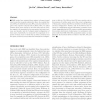Free Online Productivity Tools
i2Speak
i2Symbol
i2OCR
iTex2Img
iWeb2Print
iWeb2Shot
i2Type
iPdf2Split
iPdf2Merge
i2Bopomofo
i2Arabic
i2Style
i2Image
i2PDF
iLatex2Rtf
Sci2ools
JOCN
2010
2010
Perception of Face Parts and Face Configurations: An fMRI Study
■ fMRI studies have reported three regions in human ventral visual cortex that respond selectively to faces: the occipital face area (OFA), the fusiform face area (FFA), and a face-selective region in the superior temporal sulcus (fSTS). Here, we asked whether these areas respond to two first-order aspects of the face argued to be important for face perception, face parts (eyes, nose, and mouth), and the T-shaped spatial configuration of these parts. Specifically, we measured the magnitude of response in these areas to stimuli that (i) either contained real face parts, or did not, and (ii) either had veridical face configurations, or did not. The OFA and the fSTS were sensitive only to the presence of real face parts, not to the correct configuration of those parts, whereas the FFA was sensitive to both face parts and face configuration. Further, only in the FFA was the response to configuration and part information correlated across voxels, suggesting that the FFA contains a unifie...
| Added | 28 Jan 2011 |
| Updated | 28 Jan 2011 |
| Type | Journal |
| Year | 2010 |
| Where | JOCN |
| Authors | Jia Liu, Alison Harris, Nancy Kanwisher |
Comments (0)

